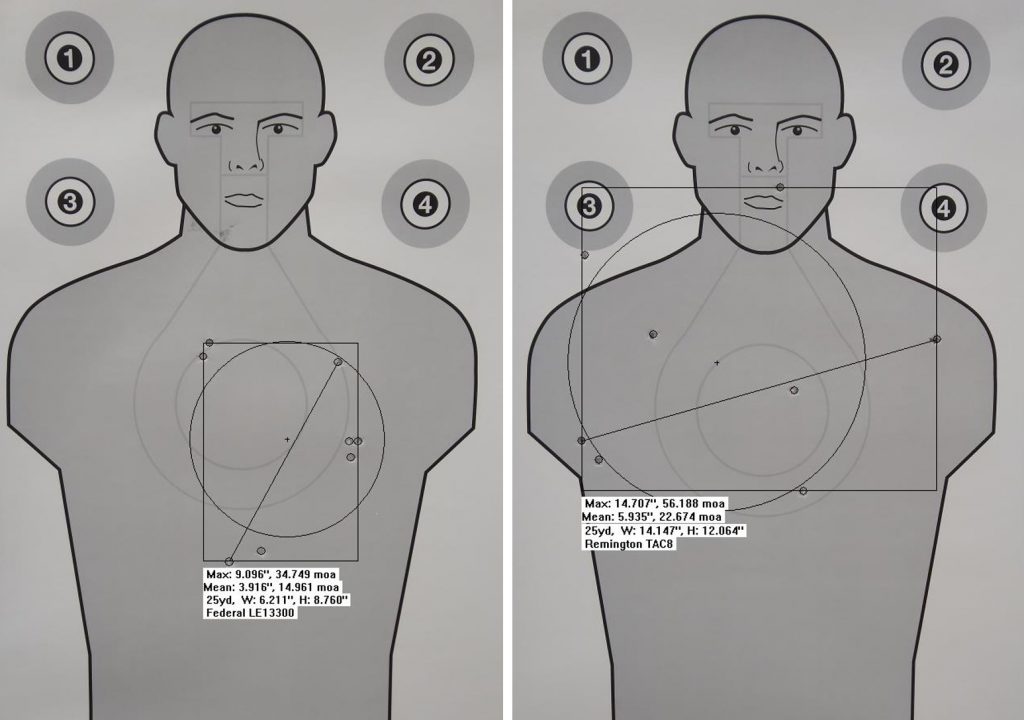We’re back with another installment of our defensive ammo range report series. Once again, Widener’s Reloading & Shooting Supply has provided us with some ammo for testing, so I took to the range to pattern some buckshot and accuracy test some slugs.
Basics of Shotgun Terminal Ballistics
The 12 gauge shotgun is widely regarded by many to be the top performer with regards to terminal effectiveness in the armed citizen’s arsenal. The go-to anti-personnel load is buckshot, which consists of a shot shell loaded multiple smaller projectiles known as shot. The most common buckshot size used for defensive or tactical applications is 00 (pronounced “double-aught”). 00 shot shells generally contain eight or nine .330 caliber projectiles. To put that in context, one pull of the trigger is essentially the same as shooting eight or nine 9mm ball rounds all simultaneously. Buckshot produces some serious wound channels, and there is a reason why many folks regard the “stopping power” of the shotgun as second to none.
The other type of load that I’m testing today – and which you will commonly find used in police/military/defensive situations – is the rifled slug. A 12ga slug is one large chunk of lead about 3/4″ in diameter that weighs about an ounce. It’s called a rifled slug because there are spiral grooves etched onto the side of the projectile to help it stabilize in flight after being launched from the smooth bore of a shotgun. A good way to think about a rifled slug is like an improved version of a Revolutionary War-era musket ball. Rifled slugs generally exhibit deep penetration with very little deformation. That means that they possess perfectly adequate terminal effectiveness for the anti-personnel role, but they aren’t anything special on that front. The real strengths of a slug are twofold: it extends the effective/safe range of the shotgun well beyond what you see with buckshot, and it does an excellent job of penetrating through intermediate barriers to still smack the target that’s waiting on the other side.
To elaborate a little on that last point: the multiple projectiles in a shot shell will spread over distance. While that will ensure that at least one pellet hits the target somewhere, that spread serves to both reduce overall terminal effectiveness and increase risk of stray pellets missing the intended target over distance. Most people think of a 12ga shotgun loaded with 00 buckshot as a 25 yard gun. With slugs, you can easily hit man-sized targets out to 100+ yards, but the deep penetration is a huge liability inside a structure – especially multi-unit housing structures like apartment complexes. For that reason, buckshot will be the go-to load for most home-defense situations. The short distances at which in-home engagements occur play to buckshot’s strengths. The spread won’t be that dramatic at typical in-home ranges, and the high level of terminal effectiveness will help to end fights more quickly.
12ga Buckshot Pattern Testing Protocol
The typical way to determine whether the characteristics of a given buckshot load are favorable is to pattern the shot at different ranges. What that means is to simply fire single shots of the chosen load a target at various distances and measure the size of the resulting shot pattern. Ultimately, what we really want is a tighter pattern. Tighter patterns are safer (to everybody but the intended target, that is) and more effective from a terminal ballistics standpoint.
Widener’s sent me two loads to pattern: Federal Tactical 00 8-pellet Buck with Federal’s Flitecontrol wad and Remington Express Tac 12 00 8-pellet Buck. Both loads are 12 gauge 2-3/4″ shells that contain 8 pellets of 00 buckshot. The Federal load is a low-recoil load that advertises a muzzle velocity of 1145 FPS, and the Remington load advertises muzzle velocities of 1325. The other notable difference is the wad – or the plastic cup that holds the pellets within the shell. The Remington load uses a standard cup wad, and the Federal load uses Federal’s proprietary Flitecontrol wad, which is designed to help hold the shells together better over distance.
I fired several shots of each load at Johnny Ringo from distances of 5, 15, 25, and 35 yards. The test gun was my 18.5″ barrel Remington 870 with cylinder choke. I measured the resulting patterns using On Target PC target analysis software. Below, you will see pictures of the most “typical” or average patterns for each load at each distance.
The Results
Five Yards
At 5y, which would be a pretty typical in-home shot, there is already an obvious difference between the two loads. With that said, both loads maintain acceptably tight patterns. I would be comfortable using either load at this distance.
Fifteen Yards
As at 5y, at 15y we can see a very noticeable difference in pattern size. The Federal load clearly has a better pattern. But also as at 5y, we can see that both patterns are still very acceptable for real-world purposes at this distance. The Federal load probably offers better chances of more rapid incapacitation due to its tighter pattern, and it will reduce liability of a stray round in instance of sub-par marksmanship. But assuming that you maintain a good high-center-chest aiming point and apply those fundamentals, I think it’s fair to say that both loads will get the job done at 15y. It’s also important to note that a 15y shot inside your own home would be very unlikely. It’s a little more realistic if you consider the possibility of things spilling over into the front yard, though.
Twenty-Five Yards
At 25 yards, there is no contest. I would not be willing to use the Remington load at this distance. One pellet is completely off the target, and only two of the eight pellets hit the vital zone (yes, there is a pellet that hit him in the mouth, but that’s not where I was aiming). On the other hand, the Federal load pattern size is only about a half inch bigger than the Remington pattern was at fifteen yards! It’s small enough that all or almost all of the pellets would still strike the vital zone with good shot placement. 25y may be farther than you would ever shoot inside your home, but if you can envision a scenario where the fight might occur out in your yard or farm, then this matters.
Thirty-Five Yards
Just to prove a point, I pushed this test out to 35y, and that’s when I finally got the Federal load to “fail”. As you can see, the Remington load produces completely unacceptable groups; four pellets missed the target entirely, one was a graze, and the other three that hit all completely missed the vital zone. In contrast, the Federal load kept 5 out of 8 pellets in the vital zone, and had only one shot miss/graze the target. This is very typical of all the Federal shots I fired at this distance; in all instances, I had one pellet that was a very near miss.
Conclusions
The Federal load I tested is the clear winner over the Remington, but what does that actually mean for you as the end user? Don’t assume that the Federal load is automatically superior for your purposes. A 25+ yard shot just may not be a reality for your individual situation, so why stress about ensuring you have ammo to meet a situation that you are not going to experience?
Both loads do just fine at distances of 15y and in, which accounts for the longest indoor shot 99% of Americans might have to take. Keep that in mind when choosing a load for your gun. With all that said, my preference is still going to be for the tighter-patterning load, all other things being equal. But what if all other things aren’t equal? Price and availability have to factor into your decision-making process as well.
Regardless of which buckshot load you decide to put in your home defense shotgun, you need to head to Widener’s to make it happen. They will take care of you with fast shipping and a great selection that includes these two loads as well as many other quality 12ga 00 buck rounds. The other thing you need to do is pick up a few extra rounds and conduct pattern testing out of your shotgun, because your results may vary from mine.
Remember to come back next week, when I’ll post the follow-up to this one. I also did some accuracy testing for some different slugs, and we’ll take a look at those results. Until then, stay dangerous!






